Thermal Analysis of Dry-Type Air-Core Coils for the Optimization of Passive Filtering Systems
Abstract
:1. Introduction
- The average temperature rise method, which cannot reveal the hot spots.
- The finite difference method (FDM), which cannot compute the local fluid temperature or obtain the hot spots despite describing the heat transfer process.
- The finite element method (FEM), which is the best option to obtain a detailed distribution of the temperatures in the coil.
2. Case Study
3. Proposed Study and Calculations
3.1. Electric Model of the Plant
3.1.1. Distribution Network Topology and Filtering System
3.1.2. Harmonic Overcurrent Protection
3.2. FEM Simulation
- Geometric model: For the sake of simplicity, an axisymmetric 2D simulation and an equivalent conductor cross section are considered.
- Materials: Thermal and magnetic properties are provided to define the coil materials.
- Boundary conditions: The most appropriate condition for solving the magnetic problem is that the vector potential, A, must be equal to zero at an infinite distance (r = ∞) [22]. Regarding the heat flow problem, only one single contour condition per element is set due to software constraints.
- Mesh [23]: The number of nodes for the magnetic and thermal simulations are 350,723 and 1,090,869, respectively.
3.2.1. Dry-Type Air-Core Reactor Characterization
3.2.2. Multiphysics FEM Simulation
4. Results and Discussion
4.1. Electric Model of the Plant
4.2. Finite Element Analysis
4.2.1. Dry-Type Air-Core Reactor Characterization
4.2.2. Multiphysics FEA
4.2.3. Model Validation
4.2.4. Simulation Results
4.3. Recommended Practices and Requirements for Harmonic Control
5. Conclusions
- A simple method to determine the temperature of the windings of the cylinders in a reactor is developed. This method is assessed under rated conditions, both by using a theoretical approach and by analysing real measurements obtained with a pyrometer.
- A methodology to compute the impedance of dry-type air-core reactors regardless of the number of concentric cylinders is proposed. This methodology enables the calculation of the current distribution in the coil, which highly affects the temperature profile.
- A FEM model is created with the aim of estimating the power losses caused by the stray currents in the reactor. The model calculates the magnetic flux density in the device in order to accurately characterize these power losses.
- A multiphysics simulation whereby the magnetic and thermal problems are solved concurrently is proposed to obtain the profile of temperatures of the coil.
Author Contributions
Funding
Acknowledgments
Conflicts of Interest
Abbreviations
| AC | Alternating current |
| ANSI | American National Standards Institute |
| CAD | Computer aided design |
| FEA | Finite element analysis |
| FDM | Finite difference method |
| FEM | Finite element method |
| FOC | Field-oriented control |
| HDF | Harmonic distortion factor |
| IEC | International Electrotechnical Commission |
| IEEE | Institute of Electrical and Electronics Engineers |
| PCC | Point of common coupling |
| RMS | Root mean square |
| THD | Total harmonic distortion |
References
- Chen, C.S.; Lee, Y.D.; Hsu, C.T.; Ting, D.S.; Shen, C.C. Power Quality Assessment of a Hot Strip Mill with Cycloconverter Drive Systems. In Proceedings of the Industry Applications Conference, 42nd IAS Annual Meeting, New Orleans, LA, USA, 23–27 September 2007. [Google Scholar]
- Hosoda, H.; Kodama, S.; Tessendorf, R. Large PWM Inverters for Rolling Mills. Iron Steel Technol. 2008, 5, 65–73. [Google Scholar]
- Chattopadhyay, A.K. Alternating Current Drives in the Steel Industry, Advancements in the last 30 years. In Industrial Electronics Magazine; IEEE: Piscataway, NJ, USA, 2010; Volume 4, pp. 30–42. [Google Scholar] [CrossRef]
- Orcajo, G.A.; Rodriguez, D.J.; Ardura, G.P.; Cano, J.M.; Norniella, J.G.; Llera, T.R.; Cifrian, R.D. Dynamic Estimation of Electrical Demand in Hot Rolling Mills. In IEEE Transactions on Industry Applications; IEEE: Piscataway, NJ, USA, 2016; Volume 52, pp. 2714–2723. [Google Scholar] [CrossRef] [Green Version]
- Vicente, A.; Picon, A.; Arteche, J.A.; Linares, M.; Velasco, A.; Sainz, J.A. Magnetic field-based arc stability sensor for electric arc furnaces. Measurement 2020, 151, 107134. [Google Scholar] [CrossRef]
- Xie, X.; Zhang, J.; Tao, S.; Xu, M.; Li, F.; Hang, Y.; Zhang, L.; Tang, H.; Miao, H.; Li, Y. Common accidents and precautions of Dry-type Air-core reactors. In Proceedings of the 5th International Conference on Machinery, Materials and Computing Technology (ICMMCT 2017), Beijing, China, 25–26 March 2017. [Google Scholar] [CrossRef]
- Nurminen, K. Thermal Modeling and Evaluation of Harmonic Effects on a Dry Type Air Core Reactor. Ph.D. Thesis, Helsinki University of Technology, Espoo, Finland, 2008. [Google Scholar]
- Yuan, F.T.; Yuan, Z.; Liu, J.X.; Wang, Y.; Mo, W.X.; He, J.J. Research on temperature field simulation of dry type air core reactor. In Proceedings of the 2017 20th International Conference on Electrical Machines and Systems (ICEMS), Sydney, Australia, 11–14 August 2017. [Google Scholar]
- Meeker, D. Finite Element Method Magnetics. Available online: http://www.femm.info/wiki/HomePage (accessed on 1 July 2020).
- Orcajo, G.A.; Ardura, G.P.; Rodriguez, D.J.; Cano, J.M.; Norniella, J.G.; Llera, T.R.; Cifrian, R.D. Overcurrent Protection Response of a Hot Rolling Mill Filtering System: Analysis of the Process Conditions. In IEEE Transactions on Industry Applications; IEEE: Piscataway, NJ, USA, 2017; Volume 53, pp. 2596–2607. [Google Scholar] [CrossRef]
- Phipps, J.K. A Transfer Function Approach to Harmonic Filter Design. In IEEE Industry Applications Magazine; IEEE: Piscataway, NJ, USA, 1997; Volume 38. [Google Scholar]
- Rodríguez, J.R.; Pontt, J.; Newman, P.; Musalem, R.; Miranda, H.; Morán, L.; Alzamora, G. Technical Evaluation and Practical Experience of High-Power Grinding Mill Drives in Mining Applications. In IEEE Transactions on Industry Application; IEEE: Piscataway, NJ, USA, 2005; Volume 41. [Google Scholar] [CrossRef]
- Wolfgang, T. Cycloconverter Drives for Rolling Mills. In IEEE Transactions on Industry Applications; IEEE: Piscataway, NJ, USA, 1982; Volume 8, pp. 400–404. [Google Scholar]
- Brandi, E.; Abboud, R.; Calero, F. Protecting Harmonic Filters in a 600 kV HVDC Installation. In Proceedings of the 42nd Annual Western Protective Relay Conference, Spokane, Washington, DC, USA, 20–22 October 2015. [Google Scholar]
- Lacerda, D.O.; Campos, R.C.; Alves, M.F.; Zaninelli, H.R. Mechanically Switched Capacitor with Damping Network (MSCDN)—Engineering Aspects of Application, Design and Protection. In Proceedings of the IEEE/PES Transmission and Distribution Conference and Exposition, Sao Paulo, Brazil, 8–10 November 2010. [Google Scholar]
- Gajić, Z.; Hillström, B.; Mekić, F. HV Shunt Reactor Secrets for Protection Engineers. In Proceedings of the 30th Western Protective Relaying Conference, Spokane, Washington, DC, USA, 20–22 October 2003. [Google Scholar]
- MathWorks. MATLAB and Simulink for Technical Computing [Online]. 2019. Available online: https://www.mathworks.com/ (accessed on 31 August 2020).
- Goh, Y.L.; Ramasamy, A.K.; Nagi, F.H.; Abidin, A.A.Z. Numerical relay for overcurrent protection using TMS320F2812. In Proceedings of the 9th WSEAS International Conference on Circuits, Systems, Electronics, Control & Signal Processing, CSECS′10, Stevens Point, WI, USA, 29–31 December 2010; pp. 44–50. [Google Scholar]
- Alzuhairi, M.T.L. Part V: Overcurrent Portective Relays. 1997. Available online: https://www.philadelphia.edu.jo/academics/mlazim/uploads/Power%20System%20protection%20-%20Part%2005.pdf (accessed on 31 August 2020).
- Lerusalimschy, R.; Figueiredo, L.H.d.; Celes, W. Lua. Available online: http://www.lua.org/home.html (accessed on 14 July 2020).
- Henrotte, F.; Hedia, H.S.; Bamps, N.; Genon, A.; Nicolet, A.; Willy, L. A new method for axisymetric liner and nonlinear problems. In Proceedings of the Digest of the Fifth Biennial IEEE Conference on Electromagnetic Field Computation, Claremont, CA, USA, 3–5 August 1992; IEEE: Piscataway, NJ, USA, 1992; pp. 1352–1355. [Google Scholar]
- Meeker, D. Finite Element Method Magnetics (FEMM)–Version 4.2–User’s Manual. 2018. Available online: http://www.femm.info/Archives/doc/manual.pdf (accessed on 14 July 2020).
- Irasari, P.; Alam, H.S.; Kasim, M. Thermal Analysis on Radial Flux Permanent Magnet Generator (PMG) using Finite Element Method. IPTEK J. Technol. Sci. 2011, 22, 102–109. [Google Scholar] [CrossRef] [Green Version]
- Yuan, F.T.; Yuan, Z.; Chen, L.; Wang, Y.; Liu, J.; He, J. Thermal and Electromagnetic Combined Optimization Design of Dry Type Air Core Reactor. Energies 2017, 10, 1989. [Google Scholar] [CrossRef] [Green Version]
- Hak, J. Eisenlose Drosselspulen; K.F.Koeler Verlag: Leipzig, Germany, 1938. [Google Scholar]
- Rosa, E.B.; Grover, F.W. Formulas and Tables for the Calculation of Mutual and Self-Inductances. Bull. Bur. Stand. 1912, 8, 119–121. [Google Scholar] [CrossRef]
- Dwight, H.; Grover, F. Some Series Formulas for Mutual Inductance of Solenoids. In Electrical Engineering; IEEE: Piscataway, NJ, USA, 1937; Volume 56, pp. 347–353. [Google Scholar] [CrossRef]
- Yu, Q. Calculation of Three Dimensional Magnetic Field Distribution of Large Air- Core Reactor Coils. Ph.D. Thesis, The Ohio State University, Columbus, OH, USA, 1996. Available online: https://etd.ohiolink.edu/!etd.send_file?accession=osu1487935573770259&disposition=inline (accessed on 31 August 2020).
- Schneider Electric. Cathier Technique No. 83. Extra Losses Caused in High Current Conductors by Skin and Proximity Effects. 1983. Available online: http://studiecd.dk/cahiers_techniques/Extra_losses_caused_in_high_current_conductors.pdf (accessed on 31 August 2020).
- IEEE Std. C57.110-2018-IEEE Recommended Practice for Establishing Liquid-Immersed and Dry-Type Power and Distribution Transformer Capability When Supplying Nonsinusoidal Load Currents; The Institute of Electrical and Electronics Engineers: Piscataway, NJ, USA, 2018. [Google Scholar] [CrossRef]
- Field, R.F.; Radio, C.G.; Cambridge, M. Reduction of Losses in Air-Cored Coils. 1950. Available online: https://www.ietlabs.com/pdf/GR_Appnote/A51%20Field,%20Reduction%20of%20Losses%20in%20Air-cored%20Coils.pdf (accessed on 31 August 2020).
- Yong, J.; Xu, W. A Method to Estimate the Impact of Harmonic and Unbalanced Currents on the Ampacity of Concentric Neutral Cables. In IEEE Transactions on Power Delivery; IEEE: Piscataway, NJ, USA, 2016; Volume 7, pp. 1971–1979. [Google Scholar] [CrossRef]
- Yuan, Z.; He, J.-J.; Pan, Y.; Yin, X.-G.; Ding, C.; Ning, S.-F.; Li, H.-L. Thermal Analysis of Air-Core Power Reactors. ISRN Mech. Eng. 2013, 2013, 6. [Google Scholar] [CrossRef]
- Huang, D.; Wu, S.; Zhao, H. Simulation of the Effect of Solar Radiation on Hardening and Hardened Concrete Wall. 2011, 163–167, 1489–1494. Adv. Mater. Res. 2011, 163–167, 1489–1494. [Google Scholar] [CrossRef]
- Richter, R. Elektrishe Maschinen; Springer: Berlin/Heidelberg, Germany, 1924. [Google Scholar]
- Shwehdi, M.; Mantawy, A.H. Investigation of Electrical Load Disturbances Influences on Steel Factory Production Lines. Int. J. Educ. Res. 2019, 7, 41–54. [Google Scholar]
- IEEE Std. C57.16–2011 IEEE Standard for Requirements, Terminology, and Test Code for Dry-Type Air-Core Series-Connected; IEEE: Piscataway, NJ, USA, 2012. [Google Scholar] [CrossRef]
- IEEE. C57.21–2008 IEEE Standard Requirements, Terminology, and Test Code for Shunt Reactors Rated Over 500 kVA; IEEE: Piscataway, NJ, USA, 2008. [Google Scholar] [CrossRef]
- Wang, Y.; Chen, X.; Pan, Z.; Lu, H.; Wen, X.; Jiang, Z.; Chen, B.; Chen, T. Theoretical and Experimental Evaluation of the Temperature Distribution in a Dry Type Air Core Smoothing Reactor of HVDC Station. Energies 2017, 10, 623. [Google Scholar] [CrossRef] [Green Version]
- IEEE Std. 519–2014 IEEE Recommended Practices and Requirements for Harmonic Control in Electrical Power Systems; IEEE: Piscataway, NJ, USA, 2014. [Google Scholar] [CrossRef]
- IEEE Std. 1453–2015 IEEE Recommended Practice for the Analysis of Fluctuating Installations on Power Systems; IEEE: Piscataway, NJ, USA, 2015. [Google Scholar] [CrossRef]

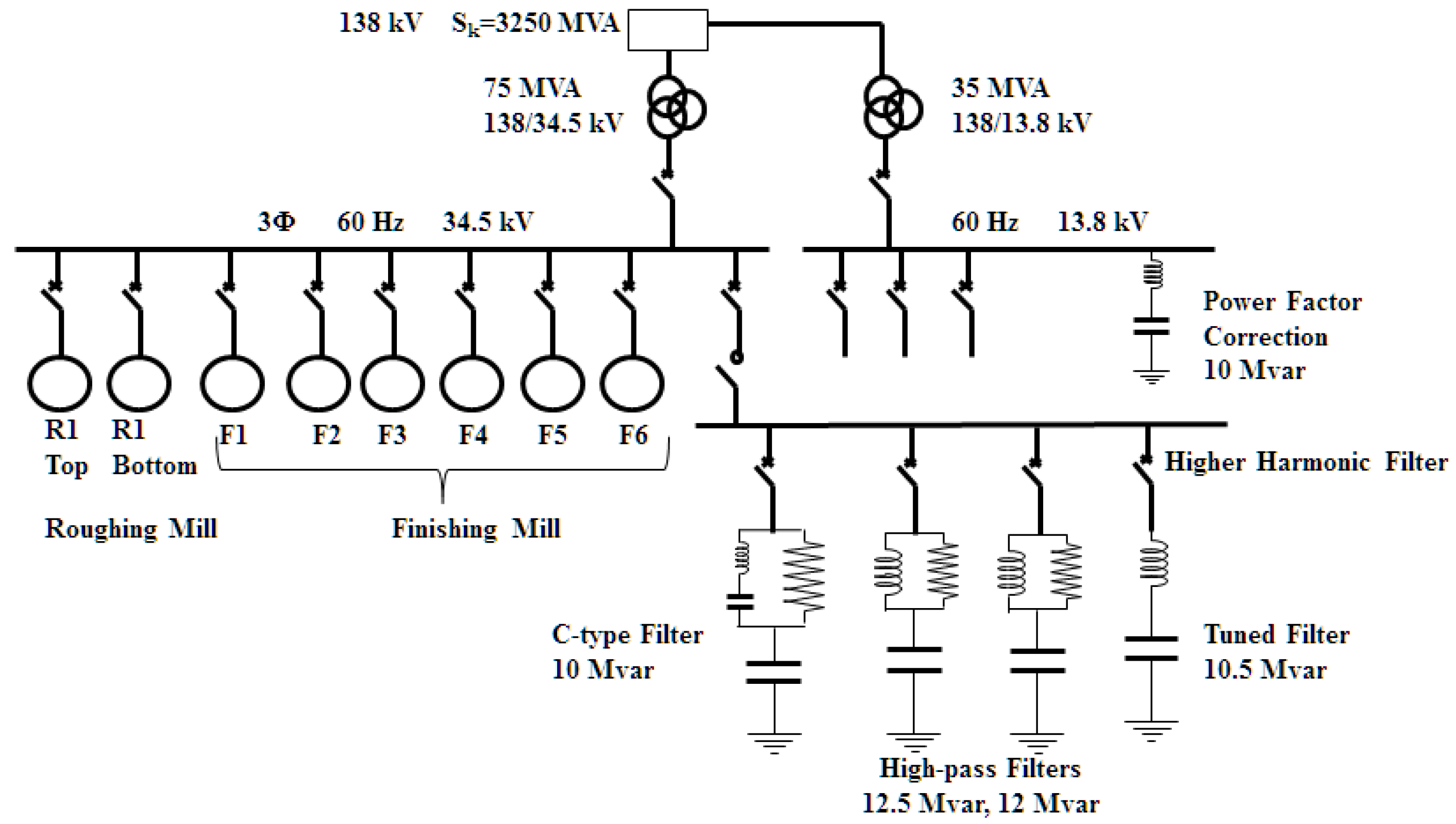

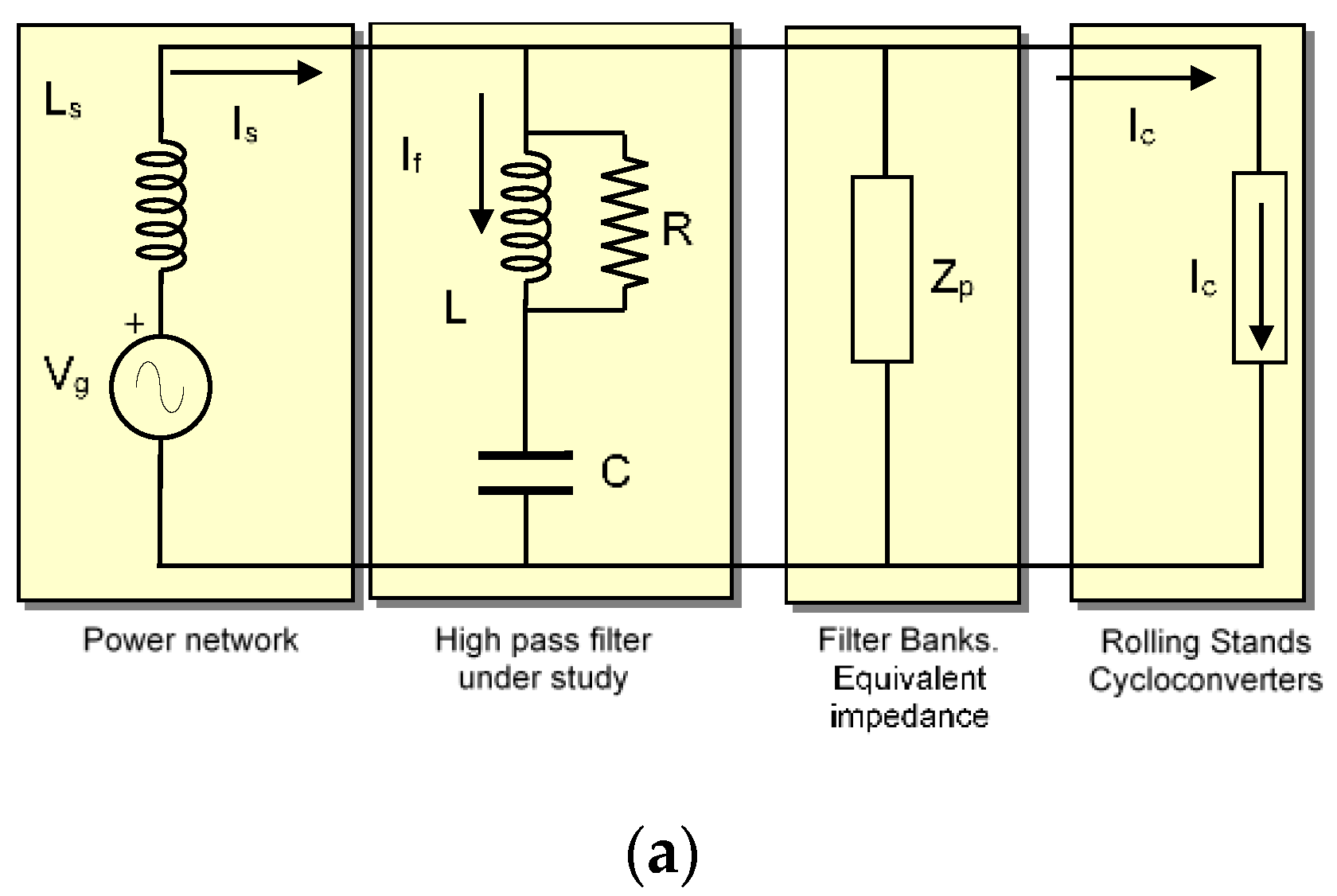
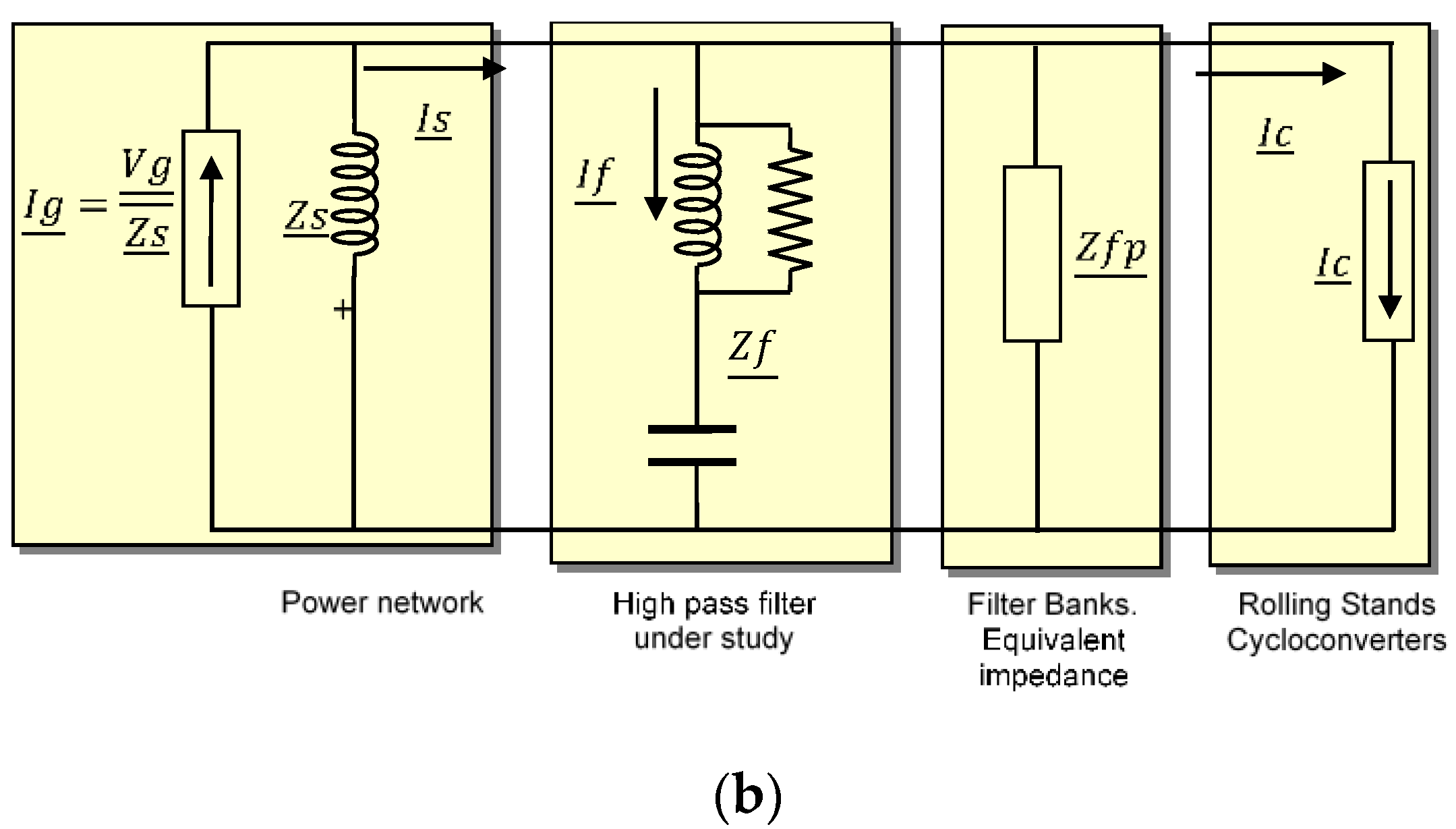




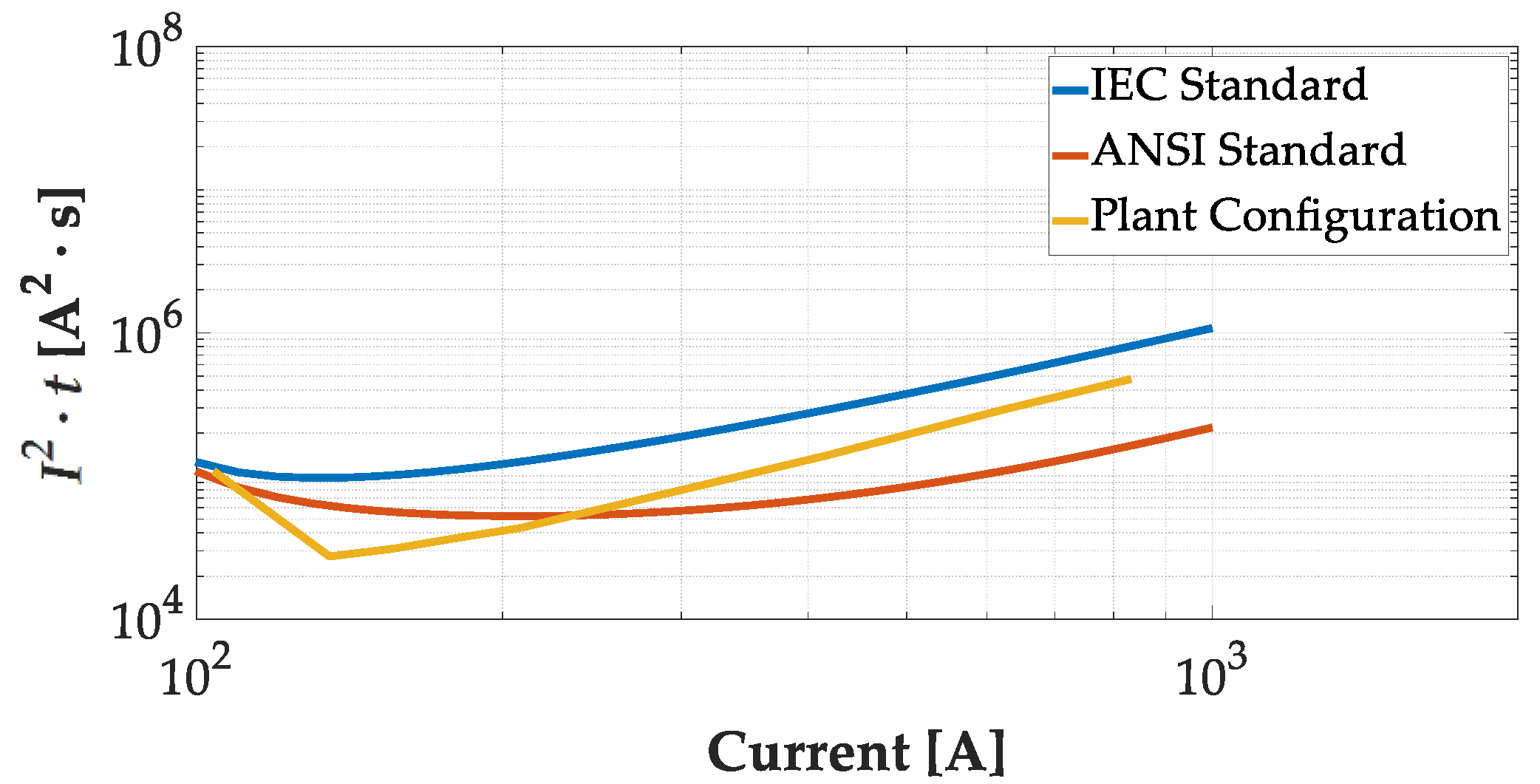
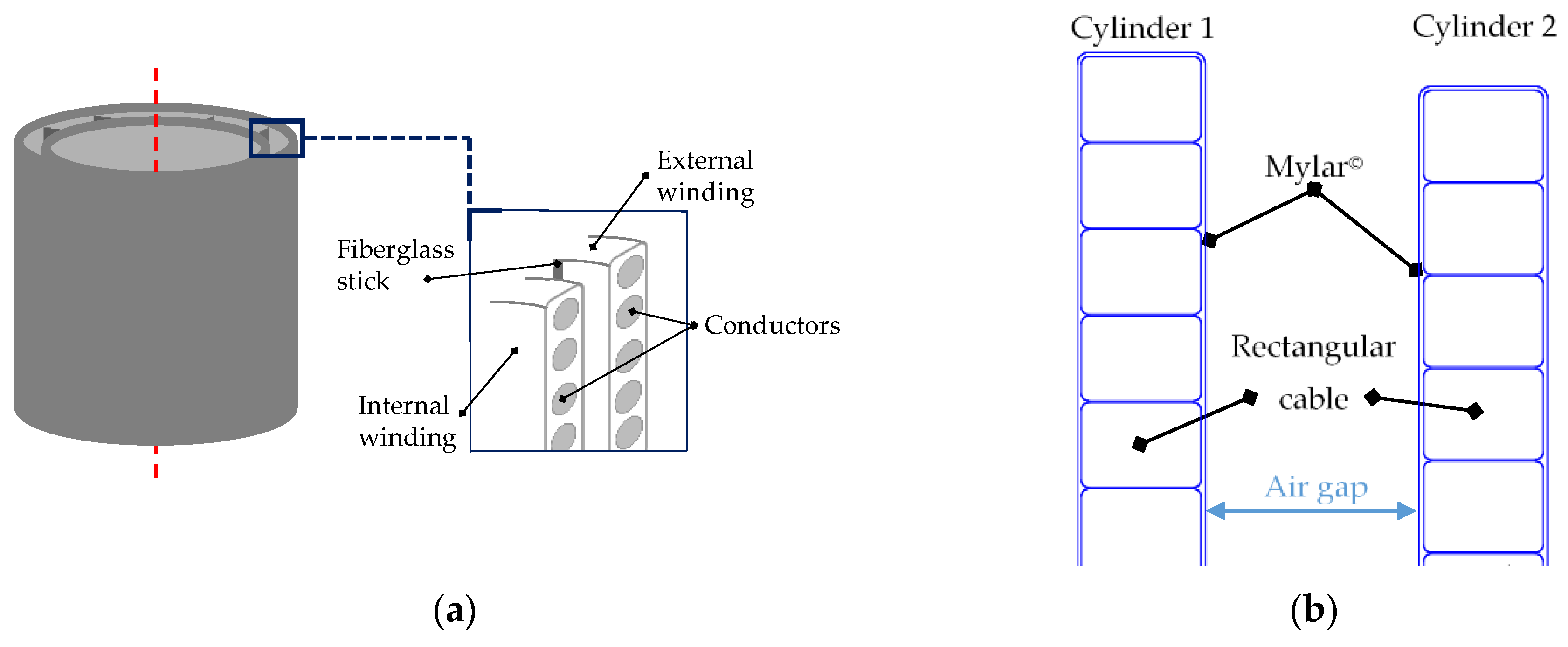
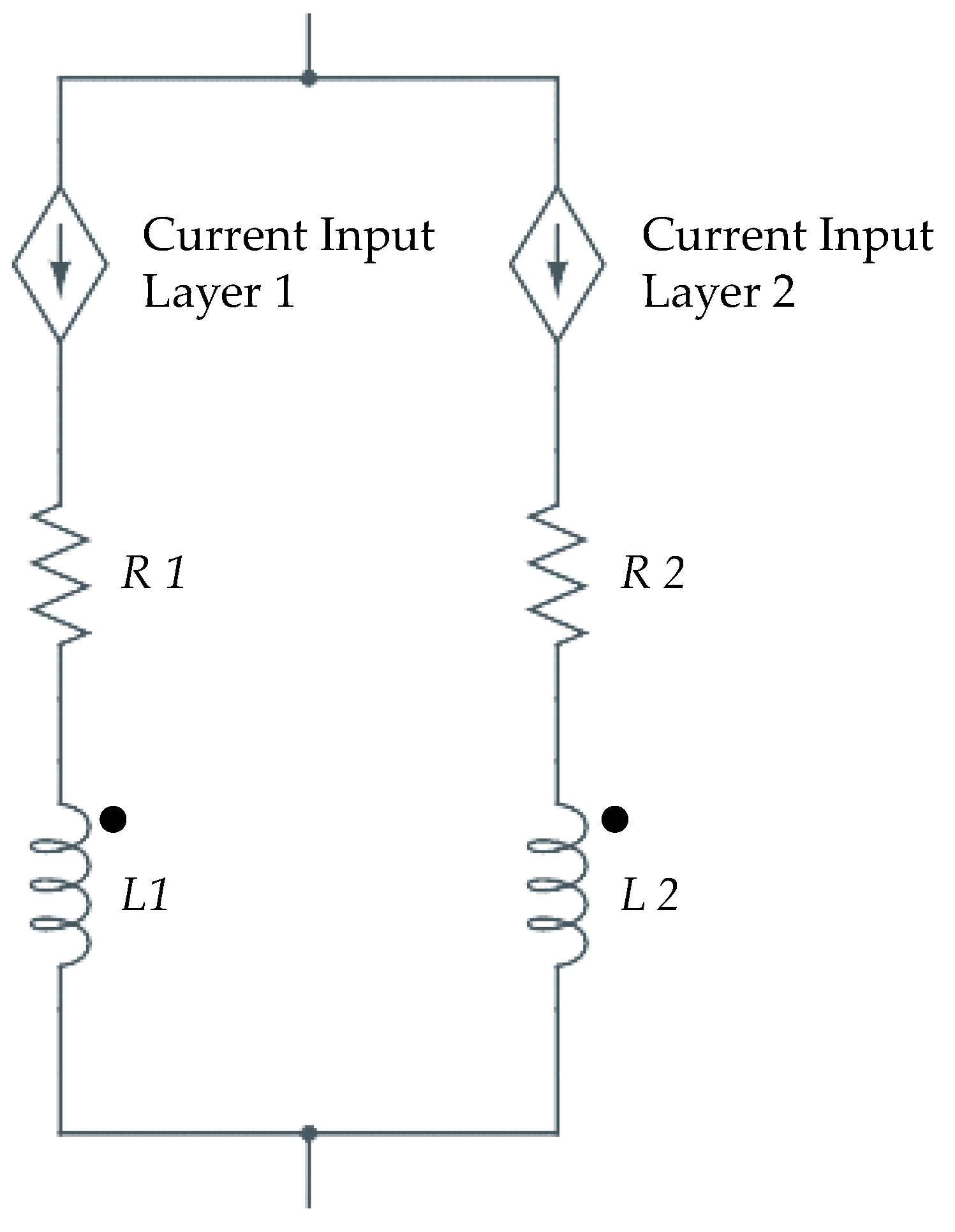
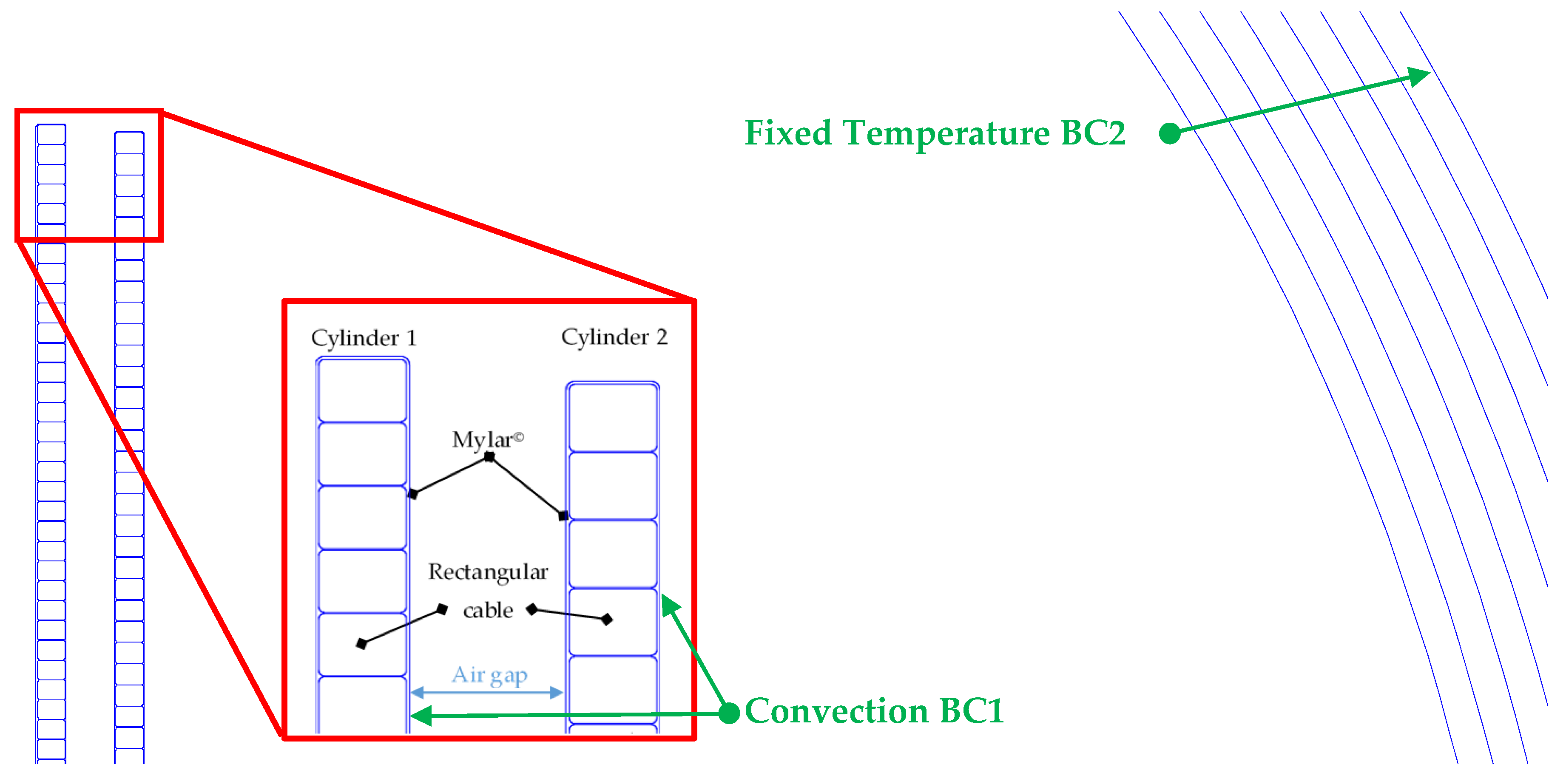
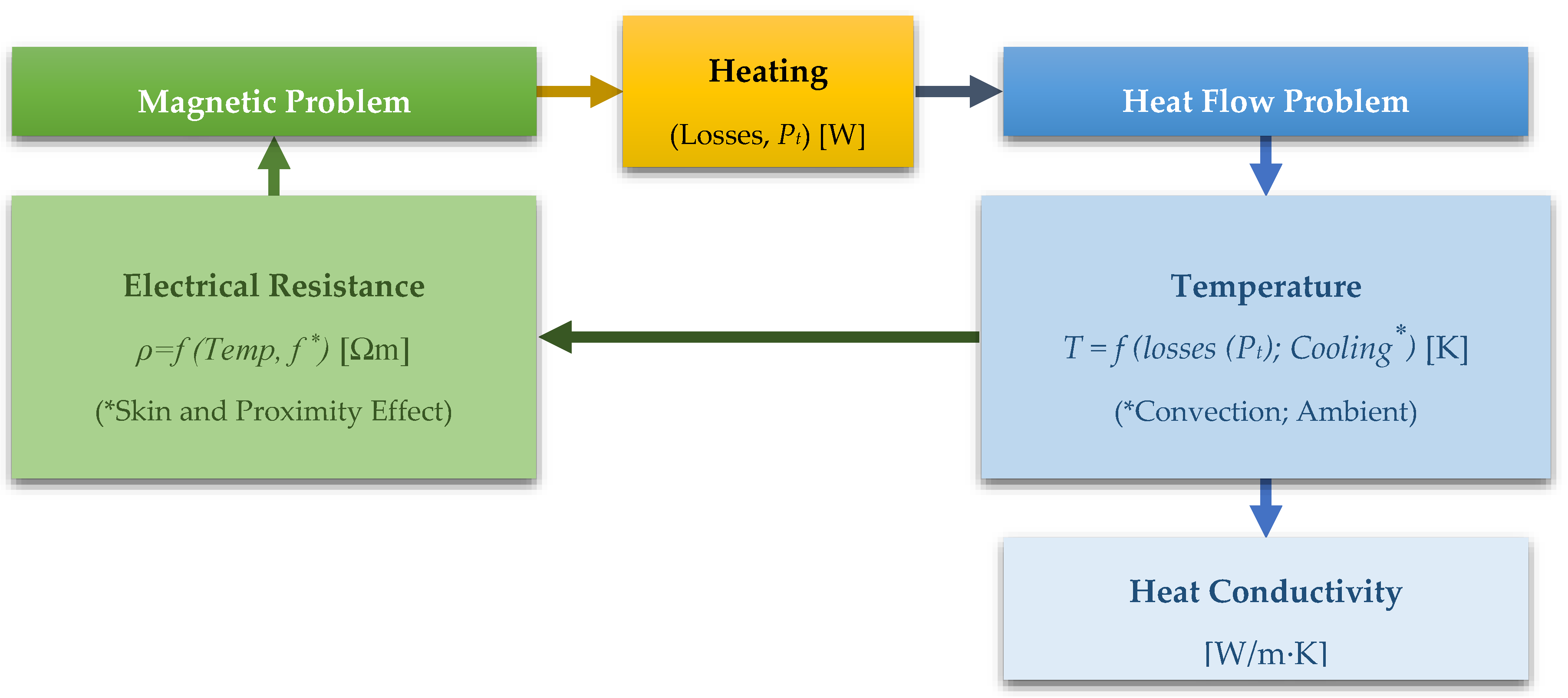
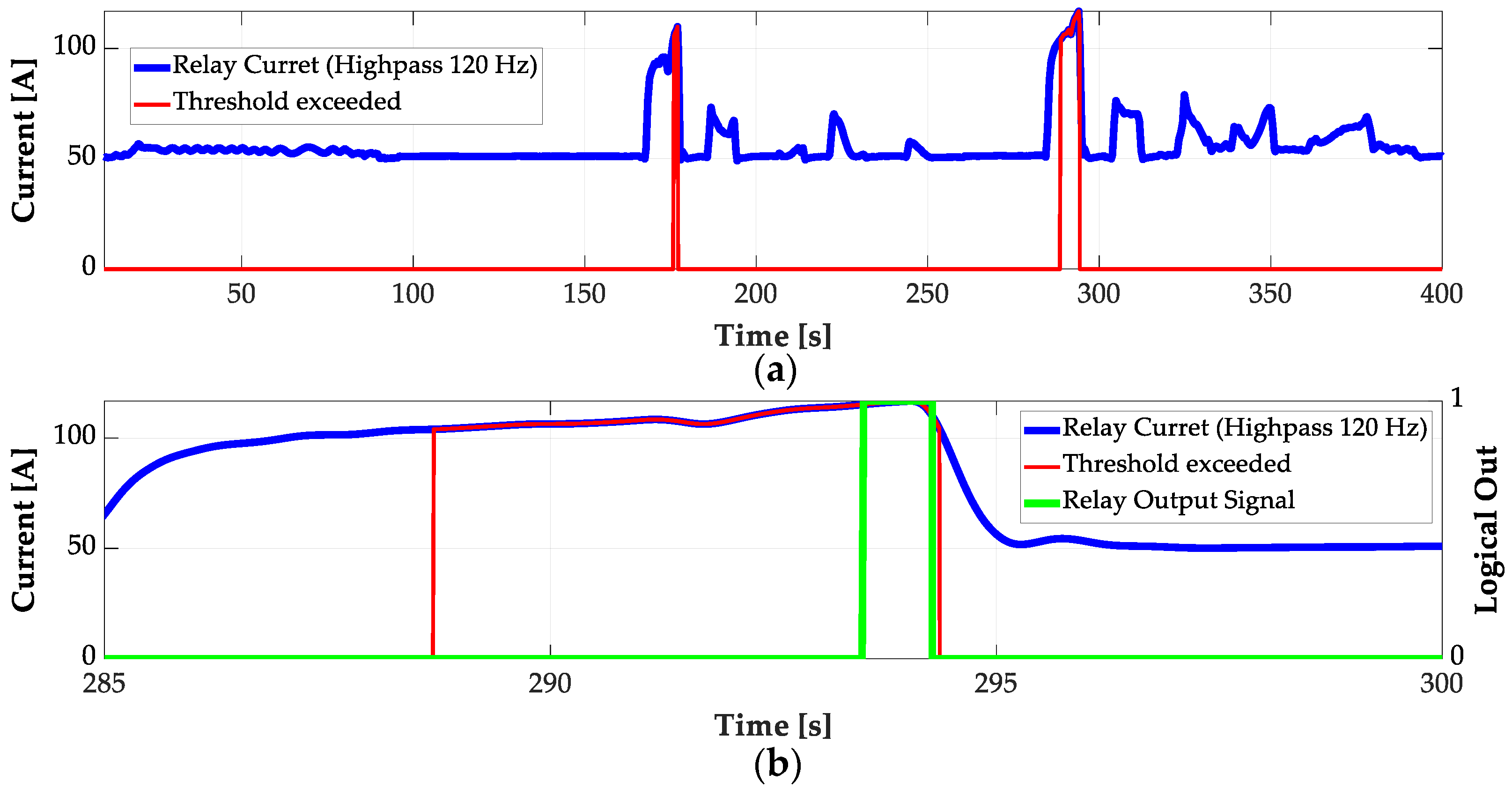

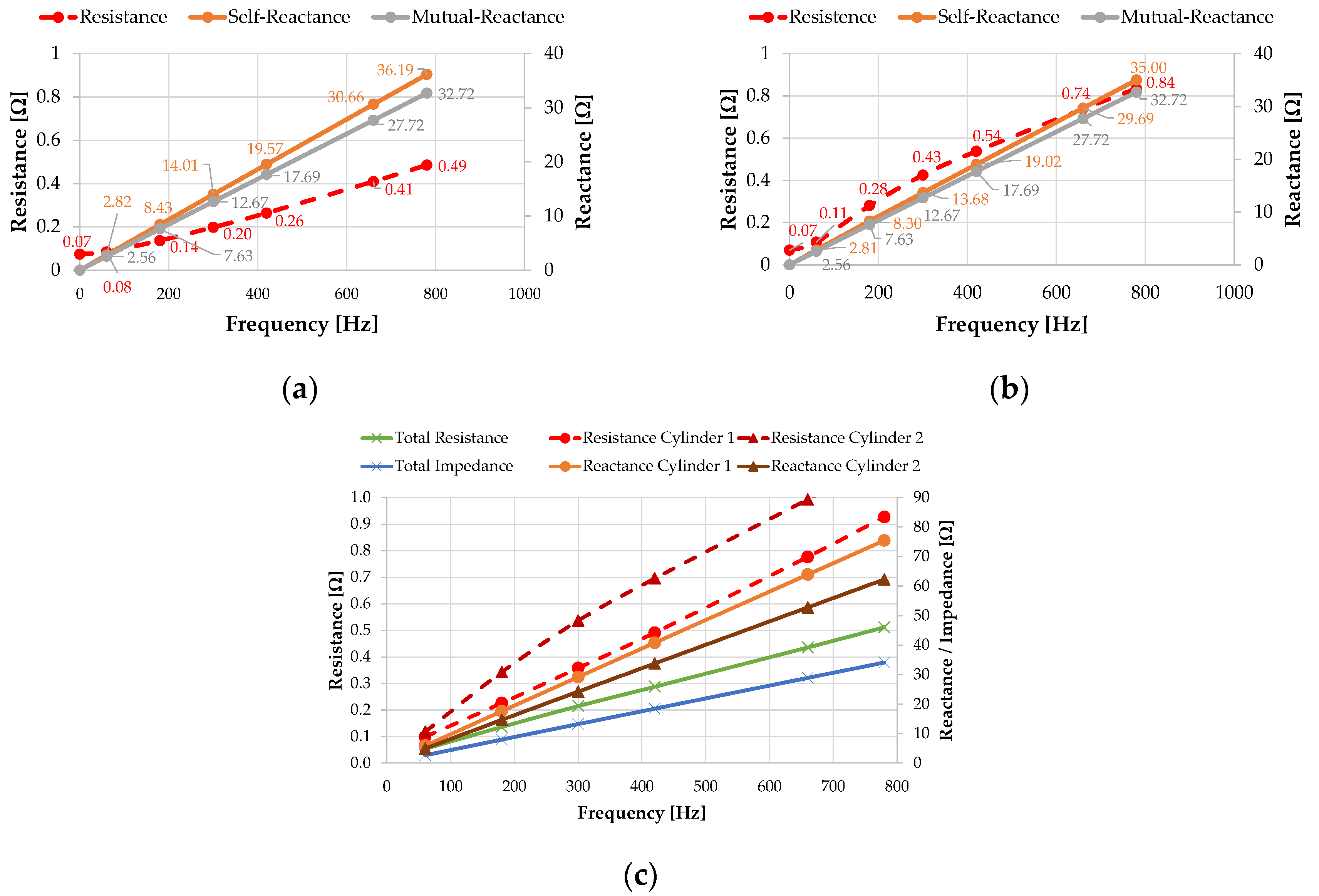
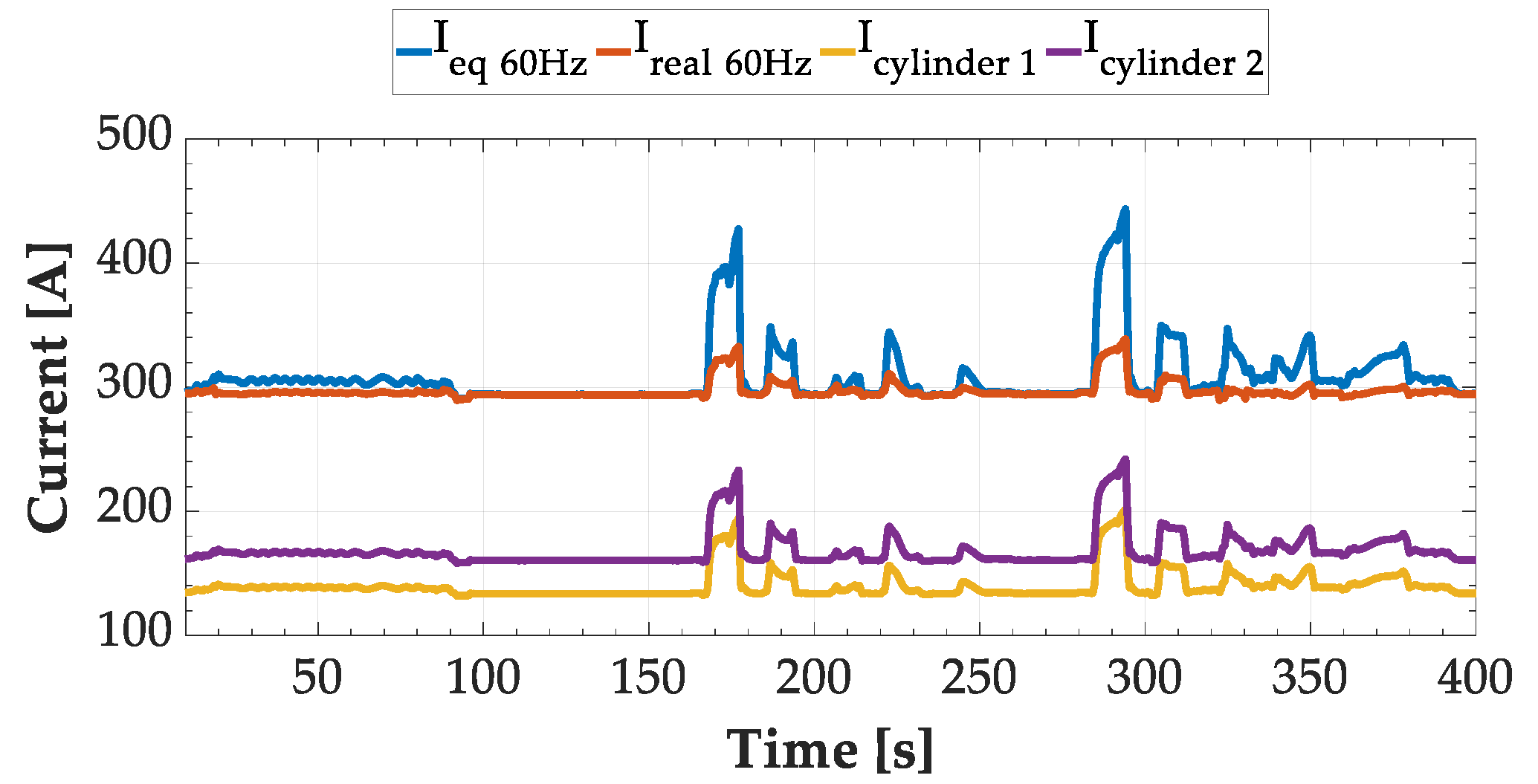
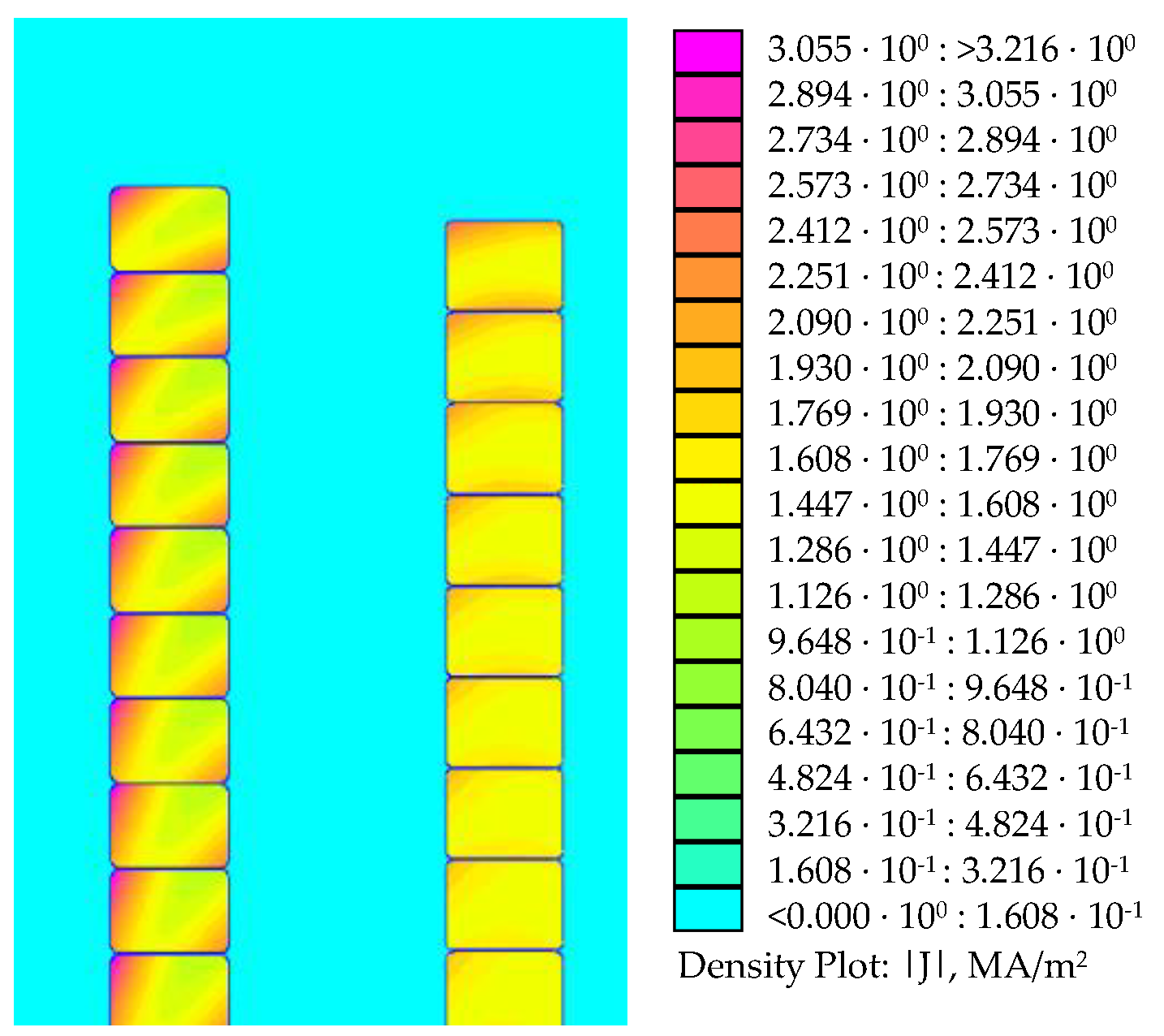



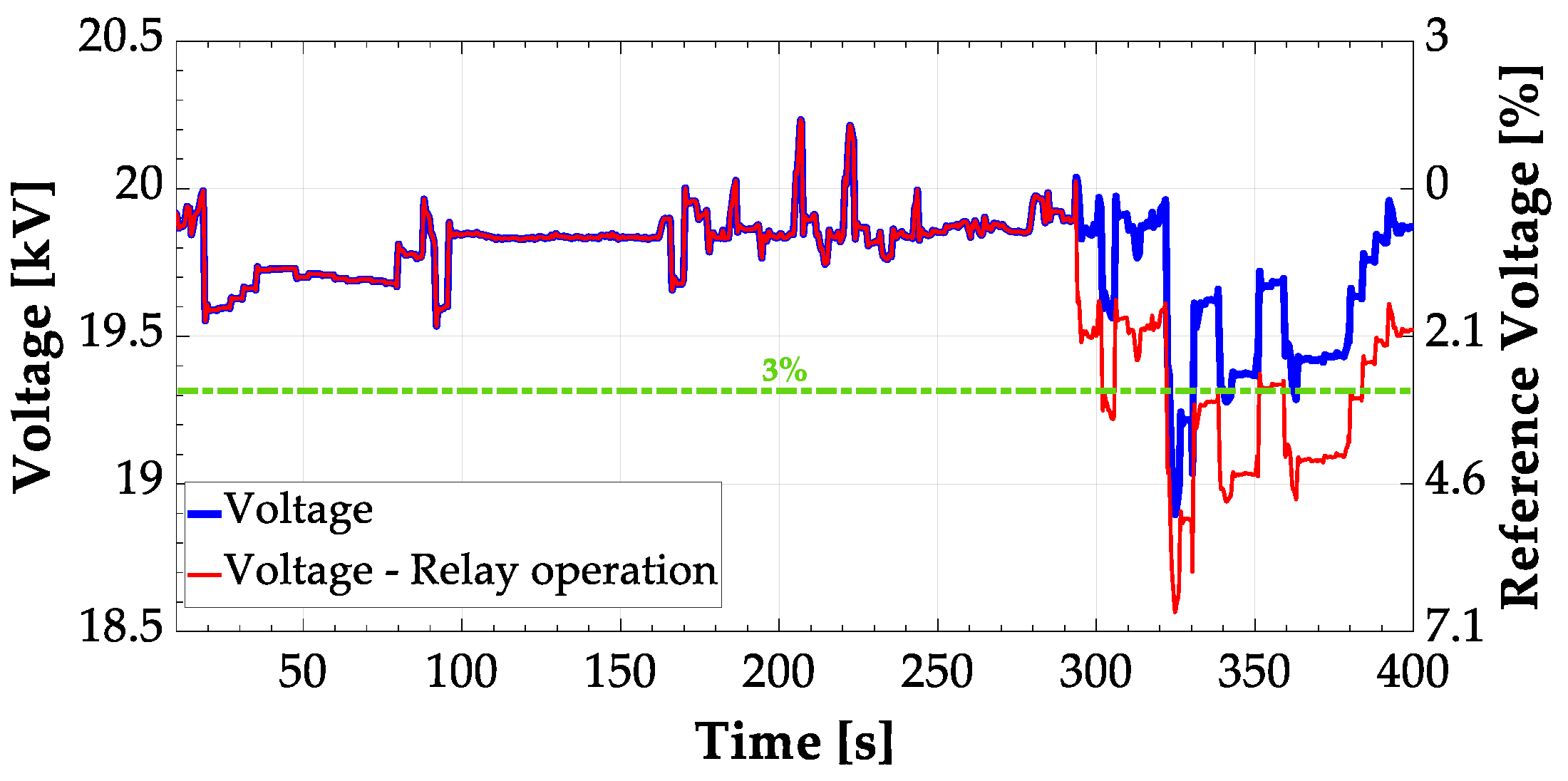
| Stands | Motor Power (MW) | Poles | Cycloconverter Topology | Transformer Power (MVA) |
|---|---|---|---|---|
| F1, F2, F3 | 8 | 6 | Circulating-current-free | 14.4 |
| F4, F5, F6 | 8 | 6 | Circulating-current | 15.7 |
| R1 (top), R1 (bottom) | 7.5 | 12 | Circulating-current-free | 14.4 |
| Filter 1 C-Type | Filter 2 Tuned | Filter 3 High Pass | Filter 4 High Pass | |
|---|---|---|---|---|
| Order of tuned frequency | 2.6 | 4.08 | 6 | 10 |
| Inductance [mH] | 54.9 | 18.7 | 7.23 | 2.6 |
| Capacitance [µF] | C11 = 127.6 C12 = 22.32 | 27 | 27 | 22.5 |
| Resistance [Ω] | 269 | 0.36 | 81.6 | 28.9 |
| Rated power [Mvar] | 10 | 10.8 | 12.5 | 12.3 |
| Order | Mag (% of Fundamental) | |
|---|---|---|
| Time 100 s | Time 288 s | |
| 3 | 0.38 | 0.97 |
| 5 | 0.36 | 6.48 |
| 7 | 0.24 | 3.23 |
| 11 | 1.45 | 2.72 |
| 13 | 0.39 | 1.28 |
| Order of tuned frequency | 2.6 | 4.08 | 6 | 10 |
| Time delay setting range | 1–10 s | |||
| Current setting range | 0.2–0.6 A | 1–3 A | 1.5–4 A | |
| Selected tap | 0.31 A | 1.2 A | 1.3 A | 3.4 A |
| Selected time delay | 10 s | 10 s | 10 s | 10 s |
| General Characteristics | Physical Characteristics | ||||
| Cylinder | |||||
| System Voltage | 34.5 kV | 1 | Gap | 2 | |
| Frequency | 60 Hz | Height | 1255 mm | Cooling air gap 15 mm | 1245 mm |
| Temperature rise (winding) | 80 °C | Diameter | 915 mm | 995 mm | |
| Air temperature | 40 °C | Number of winding turns (1 layer) | 124 | 115 | |
| Location | Outdoor | Winding turn details | 14 × 10 mm (38 parallel wires) Aluminium | 14 × 11 mm (38 parallel wires) Aluminium | |
| Fundamental current | 230 A | ||||
| Inductance | 7.23 mH | ||||
| Material (Linear B-H in All Cases) | Linear Properties 1 | Electrical Conductivity σ [MS/m] 40 °C | Special Attributes: Lamination and Wire Type | |
|---|---|---|---|---|
| Relative µr | Relative µz | |||
| Aluminium (windings) | 1 | 1 | 33.2 | Not laminated o stranded |
| Air | 1 | 1 | 0 | Not laminated o stranded |
| Material | Thermal Conductivity [W/m·K] | Volumetric Heat Capacity [MJ/m3·K] | Volumetric Heat Generation [W/m3] |
|---|---|---|---|
| Aluminium (windings) | Depends on temperature | 3 | 0 |
| Mylar (insulation) | kr = kz = 2 | 3 | 0 |
| Air | Depends on temperature | 3 | 0 |
| Real Impedance [Ω] | Mathematical Impedance [Ω] | FEM Model Impedance [Ω] | Mathematical Coupling Impedance [Ω] | FEM Coupling Impedance [Ω] | |
|---|---|---|---|---|---|
| Simple | Grower and Nagaoka | ||||
| 2.73 | 2.63 | 2.725 | 2.7 | 0.9196 | 0.91 * |
| 4τ FEM Simulation [°C] τ = 4380 s | Deviation [%] 98% Steady State FEM Simulation—4τ FEM Simulation | Real Temperature ** [°C] | Steady State FEM Simulation [°C] | |
|---|---|---|---|---|
| Cylinder 1 | 78 (84.4%) * | 1.7 | 80–85 | 85 |
| Cylinder 2 | 73.5 (83.75%) * | 1.6 | 80 | |
| Reactor | 75.75 (83.13%) * | 1.8 | 83 |
© 2020 by the authors. Licensee MDPI, Basel, Switzerland. This article is an open access article distributed under the terms and conditions of the Creative Commons Attribution (CC BY) license (http://creativecommons.org/licenses/by/4.0/).
Share and Cite
Rodríguez D., J.; Alonso Orcajo, G.; Cano, J.M.; G. Norniella, J.; Vicente, A. Thermal Analysis of Dry-Type Air-Core Coils for the Optimization of Passive Filtering Systems. Energies 2020, 13, 4540. https://doi.org/10.3390/en13174540
Rodríguez D. J, Alonso Orcajo G, Cano JM, G. Norniella J, Vicente A. Thermal Analysis of Dry-Type Air-Core Coils for the Optimization of Passive Filtering Systems. Energies. 2020; 13(17):4540. https://doi.org/10.3390/en13174540
Chicago/Turabian StyleRodríguez D., Josué, G. Alonso Orcajo, José M. Cano, Joaquín G. Norniella, and Asier Vicente. 2020. "Thermal Analysis of Dry-Type Air-Core Coils for the Optimization of Passive Filtering Systems" Energies 13, no. 17: 4540. https://doi.org/10.3390/en13174540









